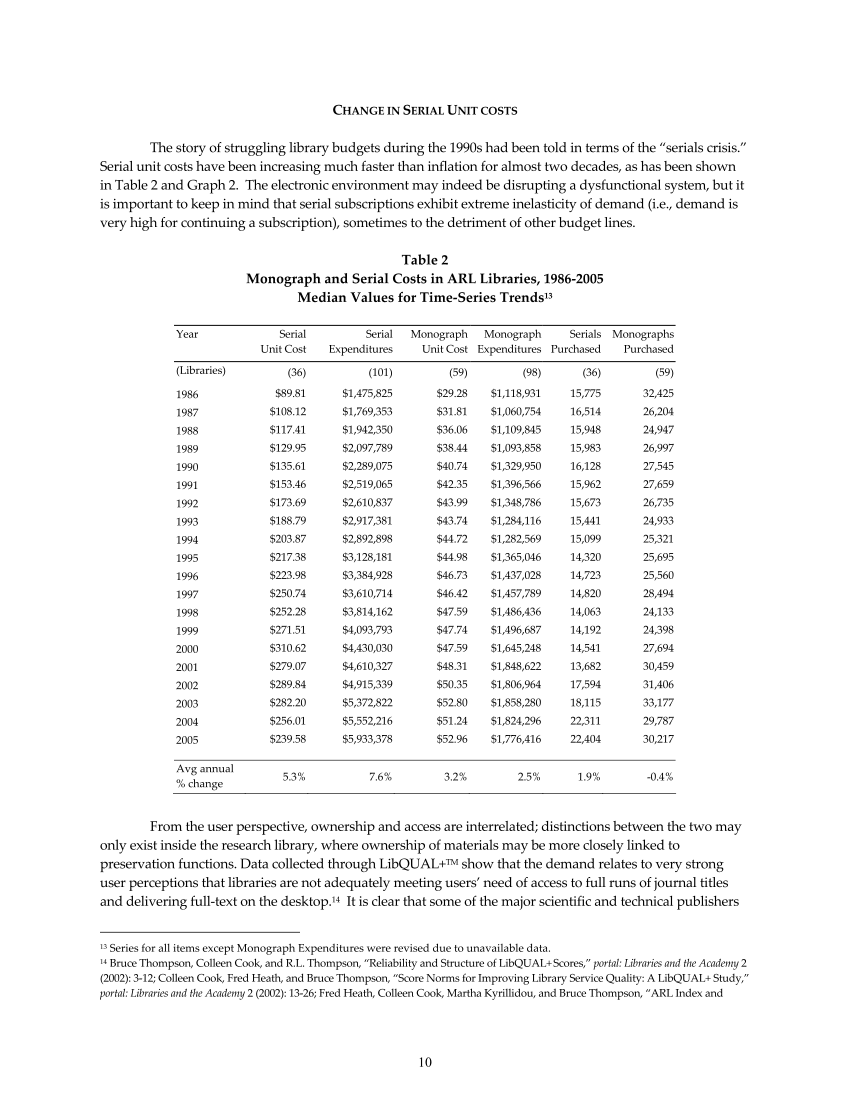10
CHANGE IN SERIAL UNIT COSTS
The story of struggling library budgets during the 1990s had been told in terms of the “serials crisis.”
Serial unit costs have been increasing much faster than inflation for almost two decades, as has been shown
in Table 2 and Graph 2. The electronic environment may indeed be disrupting a dysfunctional system, but it
is important to keep in mind that serial subscriptions exhibit extreme inelasticity of demand (i.e., demand is
very high for continuing a subscription), sometimes to the detriment of other budget lines.
Table 2
Monograph and Serial Costs in ARL Libraries, 1986‐2005
Median Values for Time‐Series Trends13
Year Serial
Unit Cost
Serial
Expenditures
Monograph
Unit Cost
Monograph
Expenditures
Serials
Purchased
Monographs
Purchased
(Libraries) (36) (101) (59) (98) (36) (59)
1986 $89.81 $1,475,825 $29.28 $1,118,931 15,775 32,425
1987 $108.12 $1,769,353 $31.81 $1,060,754 16,514 26,204
1988 $117.41 $1,942,350 $36.06 $1,109,845 15,948 24,947
1989 $129.95 $2,097,789 $38.44 $1,093,858 15,983 26,997
1990 $135.61 $2,289,075 $40.74 $1,329,950 16,128 27,545
1991 $153.46 $2,519,065 $42.35 $1,396,566 15,962 27,659
1992 $173.69 $2,610,837 $43.99 $1,348,786 15,673 26,735
1993 $188.79 $2,917,381 $43.74 $1,284,116 15,441 24,933
1994 $203.87 $2,892,898 $44.72 $1,282,569 15,099 25,321
1995 $217.38 $3,128,181 $44.98 $1,365,046 14,320 25,695
1996 $223.98 $3,384,928 $46.73 $1,437,028 14,723 25,560
1997 $250.74 $3,610,714 $46.42 $1,457,789 14,820 28,494
1998 $252.28 $3,814,162 $47.59 $1,486,436 14,063 24,133
1999 $271.51 $4,093,793 $47.74 $1,496,687 14,192 24,398
2000 $310.62 $4,430,030 $47.59 $1,645,248 14,541 27,694
2001 $279.07 $4,610,327 $48.31 $1,848,622 13,682 30,459
2002 $289.84 $4,915,339 $50.35 $1,806,964 17,594 31,406
2003 $282.20 $5,372,822 $52.80 $1,858,280 18,115 33,177
2004 $256.01 $5,552,216 $51.24 $1,824,296 22,311 29,787
2005 $239.58 $5,933,378 $52.96 $1,776,416 22,404 30,217
Avg annual
%change
5.3% 7.6% 3.2% 2.5% 1.9% -0.4%
From the user perspective, ownership and access are interrelated distinctions between the two may
only exist inside the research library, where ownership of materials may be more closely linked to
preservation functions. Data collected through LibQUAL+TM show that the demand relates to very strong
user perceptions that libraries are not adequately meeting users’ need of access to full runs of journal titles
and delivering full‐text on the desktop.14 It is clear that some of the major scientific and technical publishers
13 Series for all items except Monograph Expenditures were revised due to unavailable data.
14 Bruce Thompson, Colleen Cook, and R.L. Thompson, “Reliability and Structure of LibQUAL+ Scores,” portal: Libraries and the Academy 2
(2002): 3‐12 Colleen Cook, Fred Heath, and Bruce Thompson, “Score Norms for Improving Library Service Quality: A LibQUAL+ Study,”
portal: Libraries and the Academy 2 (2002): 13‐26 Fred Heath, Colleen Cook, Martha Kyrillidou, and Bruce Thompson, “ARL Index and
CHANGE IN SERIAL UNIT COSTS
The story of struggling library budgets during the 1990s had been told in terms of the “serials crisis.”
Serial unit costs have been increasing much faster than inflation for almost two decades, as has been shown
in Table 2 and Graph 2. The electronic environment may indeed be disrupting a dysfunctional system, but it
is important to keep in mind that serial subscriptions exhibit extreme inelasticity of demand (i.e., demand is
very high for continuing a subscription), sometimes to the detriment of other budget lines.
Table 2
Monograph and Serial Costs in ARL Libraries, 1986‐2005
Median Values for Time‐Series Trends13
Year Serial
Unit Cost
Serial
Expenditures
Monograph
Unit Cost
Monograph
Expenditures
Serials
Purchased
Monographs
Purchased
(Libraries) (36) (101) (59) (98) (36) (59)
1986 $89.81 $1,475,825 $29.28 $1,118,931 15,775 32,425
1987 $108.12 $1,769,353 $31.81 $1,060,754 16,514 26,204
1988 $117.41 $1,942,350 $36.06 $1,109,845 15,948 24,947
1989 $129.95 $2,097,789 $38.44 $1,093,858 15,983 26,997
1990 $135.61 $2,289,075 $40.74 $1,329,950 16,128 27,545
1991 $153.46 $2,519,065 $42.35 $1,396,566 15,962 27,659
1992 $173.69 $2,610,837 $43.99 $1,348,786 15,673 26,735
1993 $188.79 $2,917,381 $43.74 $1,284,116 15,441 24,933
1994 $203.87 $2,892,898 $44.72 $1,282,569 15,099 25,321
1995 $217.38 $3,128,181 $44.98 $1,365,046 14,320 25,695
1996 $223.98 $3,384,928 $46.73 $1,437,028 14,723 25,560
1997 $250.74 $3,610,714 $46.42 $1,457,789 14,820 28,494
1998 $252.28 $3,814,162 $47.59 $1,486,436 14,063 24,133
1999 $271.51 $4,093,793 $47.74 $1,496,687 14,192 24,398
2000 $310.62 $4,430,030 $47.59 $1,645,248 14,541 27,694
2001 $279.07 $4,610,327 $48.31 $1,848,622 13,682 30,459
2002 $289.84 $4,915,339 $50.35 $1,806,964 17,594 31,406
2003 $282.20 $5,372,822 $52.80 $1,858,280 18,115 33,177
2004 $256.01 $5,552,216 $51.24 $1,824,296 22,311 29,787
2005 $239.58 $5,933,378 $52.96 $1,776,416 22,404 30,217
Avg annual
%change
5.3% 7.6% 3.2% 2.5% 1.9% -0.4%
From the user perspective, ownership and access are interrelated distinctions between the two may
only exist inside the research library, where ownership of materials may be more closely linked to
preservation functions. Data collected through LibQUAL+TM show that the demand relates to very strong
user perceptions that libraries are not adequately meeting users’ need of access to full runs of journal titles
and delivering full‐text on the desktop.14 It is clear that some of the major scientific and technical publishers
13 Series for all items except Monograph Expenditures were revised due to unavailable data.
14 Bruce Thompson, Colleen Cook, and R.L. Thompson, “Reliability and Structure of LibQUAL+ Scores,” portal: Libraries and the Academy 2
(2002): 3‐12 Colleen Cook, Fred Heath, and Bruce Thompson, “Score Norms for Improving Library Service Quality: A LibQUAL+ Study,”
portal: Libraries and the Academy 2 (2002): 13‐26 Fred Heath, Colleen Cook, Martha Kyrillidou, and Bruce Thompson, “ARL Index and


















































































































































